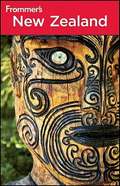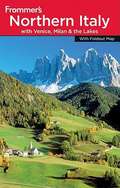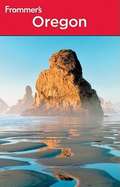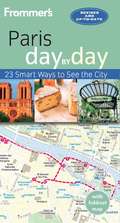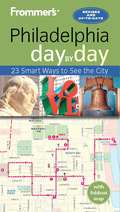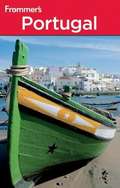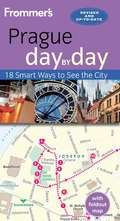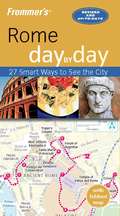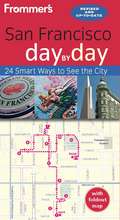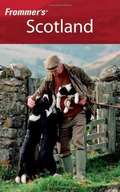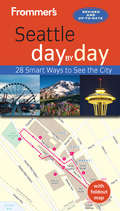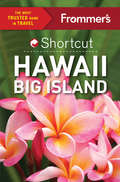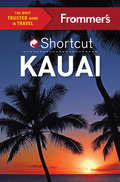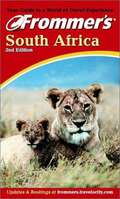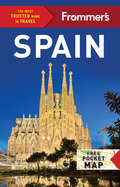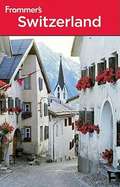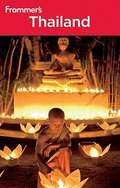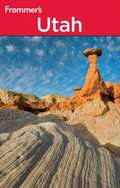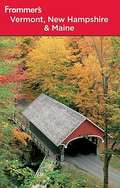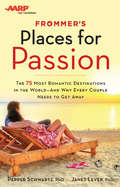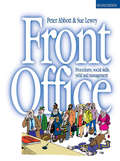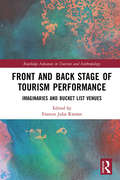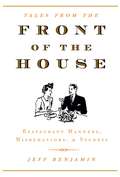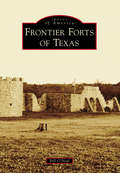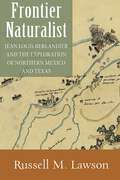- Table View
- List View
Frommer's New Zealand, 6th Edition
by Adrienne RewiWritten by a New Zealand resident, and full of personal insights and opinions, this guide takes you to one of the world's most exciting ecotourism destinations! It's much more complete and in-depth than its major competition. Whether you're dreaming of hiking along the Marlborough Sound, trout fishing in Lake Rotorua, driving the Milford Road, or feasting on sumptuous green-lipped mussels or succulent lamb, this detailed guide will help you plan the trip of a lifetime. You'll find the latest on nightlife in Auckland and Wellington and the best places to lay your head after an adventure-filled day, too. Frommer's New Zealand also features gorgeous color photos of the sights and experiences that await you.
Frommer's Northern Italy
by John MorettiTake a gondola ride on Venice's Grand Canal, where you'll find excellent views of St. Mark's Basilica. See chapter 5. Foldout map, plus detailed maps throughout Exact prices, directions, opening hours,and other practical information Candid reviews of hotels and restaurants,plus sights, shopping, and nightlife Itineraries, walking tours, and trip-planning ideas Insider tips from local expert authors
Frommer's Oregon, 7th Edition
by Karl SamsonOur expert author, an Oregon resident, is in-the-know when it comes to the best hotels, restaurants, shops, and nightlife spots in Portland and beyond, and gives readers truly insider opinions about what's worth your time and money. Extensive coverage of the great outdoors, from the Cascades to the Columbia Gorge, plus wildlife viewing, fishing, biking, and beaching along the Oregon Coast. Specialized-interest tours, including Oregon's best wineries and itineraries for families.
Frommer's Paris day by day
by Anna E. BrookeFrommer's Paris Day-by-Day Guide is the complete up-to-date reference for visitors who want to maximize their stay in the smartest, most time-efficient way. <P><P> With full-color throughout with hundreds of evocative photos, this invaluable guide offers reviews on a wide array of sightseeing, lodging, shopping, dining and entertainment options in all price ranges, and also includes thematic and walking tours of the city's best-loved neighborhoods with Frommer's trademark candid and accessible expertise.
Frommer's Philadelphia day by day
by Reid BramblettFrommer's Philadelphia Day-by-Day Guide is the complete up-to-date reference for visitors who want to maximize their stay in the smartest, most time-efficient way. With full-color throughout with hundreds of evocative photos, this invaluable guide offers reviews on a wide array of sightseeing, lodging, shopping, dining and entertainment options in all price ranges, and also includes thematic and walking tours of the city's best-loved neighborhoods with Frommer's trademark candid and accessible expertise.
Frommer's Portugal, 21st Edition
by Darwin Porter Danforth PrinceFrommer's Portugal, 21e, will feature a brand new history and culture chapter and several new detailed city maps. Veteran authors Darwin Porter and Danforth Prince provide up-to-the-minute coverage of nightlife and shopping in Lisbon, including where to find the best antiques and wine stores; insider information on the best beaches, vineyards, and historic attractions, including Portugal's 13 UNESCO World Heritage sites; detailed walking tours and nature hikes; accurate maps; and advice on how to plan a successful family vacation.
Frommer's Prague day by day
by Mark BakerFrommer's Prague Day-by-Day Guide is the complete up-to-date reference for visitors who want to maximize their stay in the smartest, most time-efficient way. <P><P> With full-color throughout with hundreds of evocative photos, this invaluable guide offers reviews on a wide array of sightseeing, lodging, shopping, dining and entertainment options in all price ranges, and also includes thematic and walking tours of the city's best-loved neighborhoods with Frommer's trademark candid and accessible expertise.
Frommer's Rome day by day
by Sylvie Hogg MurphyFrommer's Rome Day-by-Day Guide is the complete up-to-date reference for visitors who want to maximize their stay in the smartest, most time-efficient way. With full-color throughout with hundreds of evocative photos, this invaluable guide offers reviews on a wide array of sightseeing, lodging, shopping, dining and entertainment options in all price ranges, and also includes thematic and walking tours of the city's best-loved neighborhoods with Frommer's trademark candid and accessible expertise.
Frommer's San Francisco day by day
by Erika LenkertFrommer's San Francisco Day-by-Day Guide is the complete up-to-date reference for visitors who want to maximize their stay in the smartest, most time-efficient way. With full-color throughout with hundreds of evocative photos, this invaluable guide offers reviews on a wide array of sightseeing, lodging, shopping, dining and entertainment options in all price ranges, and also includes thematic and walking tours of the city's best-loved neighborhoods with Frommer's trademark candid and accessible expertise.
Frommer's Scotland (9th edition)
by Darwin Porter Danforth PrinceExperience a place the way the locals do. Enjoy the best it has to offer. The best trips start here. Whether it's the Edinburgh Festival or the fairways of St. Andrews that draw you to Scotland, our authors tell you how to get the most out of your vacation. Outspoken opinions on what's worth your time and what's not. Exact prices, so you can plan the perfect trip whatever your budget. Off-the-beaten-path experiences and undiscovered gems, plus new takes on top attractions.
Frommer's Seattle day by day
by Donald OlsonA new addition to the best-selling Day by Day series, this is a compact but thorough introduction to the touristic highlights of the Pacific Northwest. While it primarily deals with itineraries and expert suggestions on approaching the highlights of this coastal region, it also provides specific hotel, restaurant, shopping, nightlife and sightseeing recommendations, all more than sufficient for a memorable vacation. Printed on glossy paper, with four-color maps, yet at a low price.
Frommer's Shortcut Hawaii--Big Island
by Jeanne Cooper Shannon WianeckiAn essential stop for any visitor to Hawaii, the "Big Island" of Hawaii features the unforgettable active volcanoes of Volcanoes National Park (a World Heritage site), ranches tended by Hawaiian cowboys, beachfront hotels of every size, historic local towns, superb shopping, and more. And this pocket-sized Shortcut Guide covers the best of them. It gets immediately to the point, and confines itself to the vital facts about lodging, dining, sightseeing, sea-bathing, golfing, and shopping, supplying the exact amount of detail that many readers regard as sufficient. The price of each book is refreshingly low, the usefulness excitingly high.
Frommer's Shortcut Kauai
by Jeanne Cooper Shannon WianeckiRegarded by many visitors as the most beautiful island of Hawaii, Kauai is currently receiving an awesome number of pleasure-seeking tourists, who delight in its fauna, flora and other wonders of nature. <P><P>This ShortCut Guide to Kauai, confined to essential facts, covers both the sights and the practicalities, and squeezes in a surprising amount of recommendations for lodging, dining, sightseeing, sea sports, sea-bathing and relaxation. Authors of the book are natives of Hawaii, who have responded to the challenge of conveying advice that is easily and quickly consulted and yet colorfully described. It is a standout in the Frommer's travel series.
Frommer's South Africa (2nd edition)
by Pippa De BruynYou'll never fall into the tourist traps when you travel with Frommer's. It's like having a friend show you around, taking you to the places locals like best. Our expert authors have already gone everywhere you might go--they've done the legwork for you, and they're not afraid to tell it like it is, saving you time and money. No other series offers candid reviews of so many hotels and restaurants in all price ranges. Every Frommer's Travel Guide is up-to-date, with exact prices for everything, dozens of color maps, and exciting coverage of sports, shopping, and nightlife. You'd be lost without us! This exciting addition to the Frommer series, much more in depth than its major competitor, offers candid, comprehensive coverage of one of Africa's most vibrant destinations. Our guide is written by a local journalist who has lived in South Africa all her life; she knows the country intimately, and she makes it easy for you to discover its natural wonders. We'll take you to Cape Town, one of the most beautiful cities on earth, before heading off to fabulous beaches (where you can spot whales and penguins!) and the spectacular Garden Route. Look, too, for coverage of South Africa's renowned wineries, with tips from a local wine author and expert. Then it's off to Kruger National Park, plus the best private game parks, with practical advice on arranging the safari trip of a lifetime. Also included are side trips to Zimbabwe's Victoria Falls and Botswana's Okavango Delta, one of the continent's most thrilling safari destinations. Experience a place the way the locals do. Enjoy the best it has to offer. And avoid tourist traps. At Frommer's, we use 150 outspoken travel experts around the world to help you make the right choices. Frommer's. Your guide to a world of travel experience. Choose the Only Guide That Gives You: Outspoken opinions on what's worth your time and what's not. Exact prices, so you can plan the perfect trip no matter what your budget. Off-the-beaten-path experiences and undiscovered gems, plus new takes on top attractions. The best hotels and restaurants in every price range, with candid reviews. The expert guidance you need to take charge and travel with confidence. Great trips begin at Frommers.com Book flights, hotels, and rental cars. Get free updates on attractions and prices.
Frommer's Spain
by David Lyon Patricia HarrisWritten by outspoken, authoritative experts, Frommer's Spain shows travelers how to experience the country the way the locals do. This classic Frommers series includes exact prices; candid reviews of the best restaurants, attractions and hotels in every price range (from hostels to glamorous paradores); and dozens of detailed maps. We also include advice the tourist board wouldn't approve of: which sites to skip, how to avoid the crowds, and how to stretch your travel budget further, whether you're on a lavish honeymoon or backpacking it.
Frommer's Switzerland, 14th Edition
by Danforth Prince By Darwin PorterExplore the small village of Zermatt, at the base of the Matterhorn in the Valais region. See chapter 10. Detailed maps throughout Exact prices, directions, opening hours,and other practical information Candid reviews of hotels and restaurants,plus sights, shopping, and nightlife Itineraries, walking tours, and trip-planning ideas Insider tips from local expert authors
Frommer's Thailand, 9th Edition
by Ron EmmonsYou'll never fall into the tourist traps when you travel with Frommer's. It's like having a friend show you around, taking you to the places locals like best. Our expert authors have already gone everywhere you might go--they've done the legwork for you, and they're not afraid to tell it like it is, saving you time and money. No other series offers candid reviews of so many hotels and restaurants in all price ranges. Every Frommer's Travel Guide is up-to-date, with exact prices for everything, dozens of color maps, and exciting coverage of sports, shopping, and nightlife. You'd be lost without us! Frommer's holds the key to worry-free travel in this exotic land, with valuable cultural insights, the latest trip-planning advice, detailed maps, and smart tips on language, local customs, and getting around. You'll find honest, in-depth reviews of luxury beach resorts, high-tech business hotels, intimate inns, and simple guest houses and bungalows, all based on recent personal inspections. We'll show you spectacular beaches, waterfalls, floating markets, majestic temples, ancient ruins, national parks, palaces, and traditional villages. We'll lead you to amazing restaurants, and even take you elephant trekking in the Northern Hills. You'll also rely on us to guide you through the confusing, bustling, but intriguing city of Bangkok (our author, who lived there while writing this guide, knows it intimately, and discovered all sorts of hidden surprises). With Frommer's in hand, you'll experience all the wonder of Thailand!
Frommer's Utah, 8th Edition
by Eric PetersonHit the slopes in Wasatch-Cache National Forest-just one of Utah's many amazing skiing destinations. See chapter 5. Detailed maps throughout Exact prices, directions, opening hours,and other practical information Candid reviews of hotels and restaurants,plus sights, shopping, and nightlife Itineraries, walking tours, and trip-planning ideas Insider tips from local expert authors
Frommer's Vermont, New Hampshire and Maine 2010 7th Edition
by Paul KarrNew and completely revised edition! Itineraries for special interests and overall highlights: from hiking in New Hampshire's White Mountains, to spending two weeks on the Maine Coast, to seeing the Best of Vermont in a week. Each chapter offers an entire "Enjoying the Outdoors" section, with tips and suggestions for every season. The Best of New England section offers a wide range of accommodations and dining choices. Includes an overview of the region's mountains, forests, and coastlines and a history of the people and landscape. If you're a leaf-peeper, we list The Best Places to See Fall Foliage
Frommer's/AARP Places for Passion
by Pepper Schwartz Janet LeverToday Show contributor, AARP Sex and Relationship Ambassador, and best-selling author Pepper Schwartz has teamed up with Janet Lever (former coauthor of Glamour's Sex and Health column) to create a guidebook to the world's sexiest destinations. Along with the detail-rich text on their top 75 picks, the authors make a solid case for why traveling together is an important factor in improving -- and sustaining -- the romance in our lives. This witty, helpful book also dishes the dirt on how to pick the right destinations, why travel can rekindle sparks, tricks and tips for passion, and ways to constructively negotiate with your significant other about vacation plans.
Front Office
by P. Abbott S. LewryDesigned for all students of hospitality and tourism management, the second edition of this best selling text gives a modern approach to front office operations and management using realistic scenarios set in the hotel environment Key features of this essential text:· user-friendly style of writing and accessible page layout enables students to use it as a reference book as well as a textbook· updated in the light of recent developments such as global distribution systems and the internet· greater focus on increasing yield and expansion of vital management aspects such as staffing and equipment· additional extended, practical exercise material.Front Office reflects the importance of different features of the receptionist's work and is divided into four main sections:· Procedural aspects· Dealing with people· Increasing yield· Management aspectsFront Office is ideal for GNVQ/ BTEC students, those taking the professional exams of the HCIMA, and for undergraduates and postgraduates studying hospitality and tourism management and all relevant executive courses.
Front and Back Stage of Tourism Performance: Imaginaries and Bucket List Venues (Routledge Advances in Tourism and Anthropology)
by Frances Julia RiemerFront and Back Stage of Tourism Performance situates our travel imaginaries, those dream destinations on our travel bucket lists, as co-constructed by the tourist industry, state development policies, and community negotiations, and as framed by modernity’s new global cultural economy. As more people travel for pleasure than ever before, host communities and intermediaries are presented with tourism opportunities that all too often become flashpoints for local contestation and mechanisms for displacement. The ethnographically-grounded chapters describe tourist encounters shaped by geopolitics, complicated by war, and troubled by and enacted within the economic inequities of neocolonialism. The points of contact afford a unique vantage from which to view cultural identity, entrepreneurial strategizing, and natural resource management as global politics and relations of difference. They also illustrate the power of social networks, cultural display, and artistic performance as collective presentation, management apparatus, and structural critique. Drawing on a range of international case studies, this book will appeal to those interested in tourism, anthropology, global studies, environmental issues, microeconomics, and identity studies.
Front of the House
by Jeff BenjaminIn the bestselling tradition of Restaurant Man and Setting the Table, Front of the House is a revealing and wryly humorous behind-the-scenes look at the gracious art of great restaurant service. Great restaurant service is a gracious art that's been studied, practiced and polished by Jeff Benjamin, two-time James Beard Award nominee and managing partner of Philadelphia's acclaimed Vetri family of restaurants. Sagacious and observant, he beckons us behind the scenes for an insider's look at reserving a table, what your server thinks of you, what it takes to get ejected from a fine restaurant and a host of other revelations.
Frontier Forts of Texas (Images of America)
by Bill O'NealWith its vast size and long frontier period, Texas was the scene of more combat events between Native American warriors and Anglo soldiers and settlers than any other state or territory. The US Army, therefore, erected more military outposts in Texas, a tradition begun by Spanish soldados and their presidios. Settlers built blockhouses and even stockades, the most famous of which was Parker's Fort, the site of an infamous massacre in 1836. Successive north to south lines of Army forts attempted to screen westward-moving settlers from war parties, while border posts stretched along the Rio Grande from Fort Brown on the Gulf of Mexico to Fort Bliss at El Paso del Norte. Texas was the site of the first US Cavalry regiment employed against horseback warriors, as well as the experimental US Camel Corps. From Robert E. Lee to Albert Sidney Johnston to Ranald Mackenzie, the Army's finest officers served out of Texas forts, and 61 Medals of Honor were earned by soldiers campaigning in the Lone Star State.
Frontier Naturalist: Jean Louis Berlandier and the Exploration of Northern Mexico and Texas
by Russell M. LawsonThis is a true story of discovery and discoverers in what was the northern frontier region of Mexico in the years before the Mexican War. In 1826, when the story begins, the region was claimed by both Mexico and the United States. Neither country knew much about the lands crossed by such rivers as the Guadalupe, Brazos, Nueces, Trinity, and Rio Grande. Jean Louis Berlandier, a French naturalist, was part of a team sent out by the Mexican Boundary Commission to explore the area. His role was to collect specimens of flora and fauna and to record detailed observations of the landscapes and peoples through which the exploring party traveled. His observations, including sketches and paintings of plants, landmarks, and American Indians, were the first compendium of scientific observations of the region to be collected and eventually published.Here, historian Russell Lawson tells the story of this multinational expedition, using Berlandier&’s copious records as a way of conveying his view of the natural environment. Lawson&’s narrative allows us to peer over Berlandier&’s shoulder as he traveled and recorded his experiences. Berlandier and Lawson show us an America that no longer exists.
